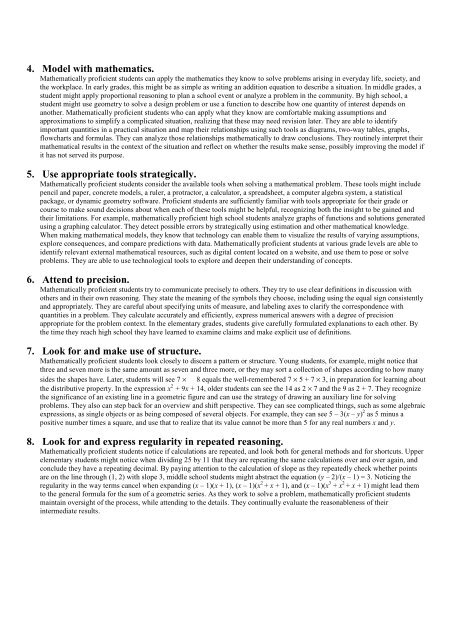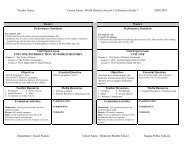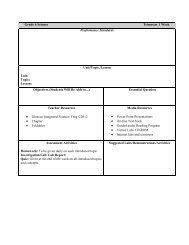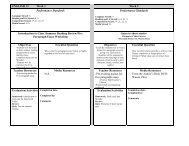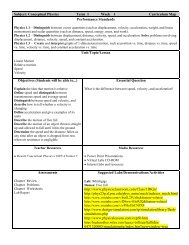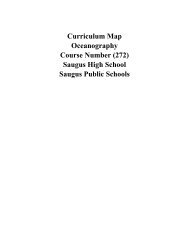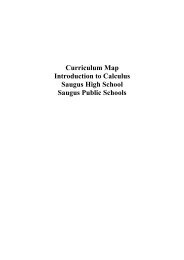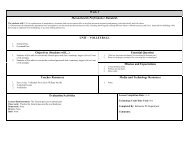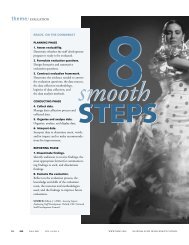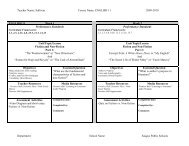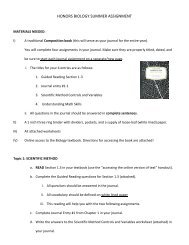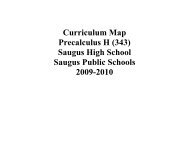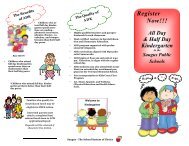Integrated Math Curriculum Map CCSS - Saugus Public Schools
Integrated Math Curriculum Map CCSS - Saugus Public Schools
Integrated Math Curriculum Map CCSS - Saugus Public Schools
You also want an ePaper? Increase the reach of your titles
YUMPU automatically turns print PDFs into web optimized ePapers that Google loves.
4. Model with mathematics.<br />
<strong>Math</strong>ematically proficient students can apply the mathematics they know to solve problems arising in everyday life, society, and<br />
the workplace. In early grades, this might be as simple as writing an addition equation to describe a situation. In middle grades, a<br />
student might apply proportional reasoning to plan a school event or analyze a problem in the community. By high school, a<br />
student might use geometry to solve a design problem or use a function to describe how one quantity of interest depends on<br />
another. <strong>Math</strong>ematically proficient students who can apply what they know are comfortable making assumptions and<br />
approximations to simplify a complicated situation, realizing that these may need revision later. They are able to identify<br />
important quantities in a practical situation and map their relationships using such tools as diagrams, two-way tables, graphs,<br />
flowcharts and formulas. They can analyze those relationships mathematically to draw conclusions. They routinely interpret their<br />
mathematical results in the context of the situation and reflect on whether the results make sense, possibly improving the model if<br />
it has not served its purpose.<br />
5. Use appropriate tools strategically.<br />
<strong>Math</strong>ematically proficient students consider the available tools when solving a mathematical problem. These tools might include<br />
pencil and paper, concrete models, a ruler, a protractor, a calculator, a spreadsheet, a computer algebra system, a statistical<br />
package, or dynamic geometry software. Proficient students are sufficiently familiar with tools appropriate for their grade or<br />
course to make sound decisions about when each of these tools might be helpful, recognizing both the insight to be gained and<br />
their limitations. For example, mathematically proficient high school students analyze graphs of functions and solutions generated<br />
using a graphing calculator. They detect possible errors by strategically using estimation and other mathematical knowledge.<br />
When making mathematical models, they know that technology can enable them to visualize the results of varying assumptions,<br />
explore consequences, and compare predictions with data. <strong>Math</strong>ematically proficient students at various grade levels are able to<br />
identify relevant external mathematical resources, such as digital content located on a website, and use them to pose or solve<br />
problems. They are able to use technological tools to explore and deepen their understanding of concepts.<br />
6. Attend to precision.<br />
<strong>Math</strong>ematically proficient students try to communicate precisely to others. They try to use clear definitions in discussion with<br />
others and in their own reasoning. They state the meaning of the symbols they choose, including using the equal sign consistently<br />
and appropriately. They are careful about specifying units of measure, and labeling axes to clarify the correspondence with<br />
quantities in a problem. They calculate accurately and efficiently, express numerical answers with a degree of precision<br />
appropriate for the problem context. In the elementary grades, students give carefully formulated explanations to each other. By<br />
the time they reach high school they have learned to examine claims and make explicit use of definitions.<br />
7. Look for and make use of structure.<br />
<strong>Math</strong>ematically proficient students look closely to discern a pattern or structure. Young students, for example, might notice that<br />
three and seven more is the same amount as seven and three more, or they may sort a collection of shapes according to how many<br />
sides the shapes have. Later, students will see 7 × 8 equals the well-remembered 7 × 5 + 7 × 3, in preparation for learning about<br />
the distributive property. In the expression x 2 + 9x + 14, older students can see the 14 as 2 × 7 and the 9 as 2 + 7. They recognize<br />
the significance of an existing line in a geometric figure and can use the strategy of drawing an auxiliary line for solving<br />
problems. They also can step back for an overview and shift perspective. They can see complicated things, such as some algebraic<br />
expressions, as single objects or as being composed of several objects. For example, they can see 5 – 3(x – y) 2 as 5 minus a<br />
positive number times a square, and use that to realize that its value cannot be more than 5 for any real numbers x and y.<br />
8. Look for and express regularity in repeated reasoning.<br />
<strong>Math</strong>ematically proficient students notice if calculations are repeated, and look both for general methods and for shortcuts. Upper<br />
elementary students might notice when dividing 25 by 11 that they are repeating the same calculations over and over again, and<br />
conclude they have a repeating decimal. By paying attention to the calculation of slope as they repeatedly check whether points<br />
are on the line through (1, 2) with slope 3, middle school students might abstract the equation (y – 2)/(x – 1) = 3. Noticing the<br />
regularity in the way terms cancel when expanding (x – 1)(x + 1), (x – 1)(x 2 + x + 1), and (x – 1)(x 3 + x 2 + x + 1) might lead them<br />
to the general formula for the sum of a geometric series. As they work to solve a problem, mathematically proficient students<br />
maintain oversight of the process, while attending to the details. They continually evaluate the reasonableness of their<br />
intermediate results.


